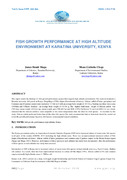| dc.contributor.author | Mugo, James Bundi | |
| dc.contributor.author | Chege, Moses Gichuho | |
| dc.date.accessioned | 2019-03-26T12:34:48Z | |
| dc.date.available | 2019-03-26T12:34:48Z | |
| dc.date.issued | 2018-10 | |
| dc.identifier.citation | Global Journal of Advanced Research, Vol-5, Issue-9 | en_US |
| dc.identifier.issn | 2394-5788 | |
| dc.identifier.uri | https://karuspace.karu.ac.ke/handle/20.500.12092/2215 | |
| dc.description.abstract | This report entails the findings of fish growth performance project that targeted high altitude environment. One such environment is Karatina university fish ponds in Kenya. Fingerlings of Nile tilapia (Oreochromis niloticus), African catfish (Clarias gariepinus) and Common carp (Cyprinus carpio) were stocked at 3.3 fish m-2 with an average body weight of 4.9-5.6 g. Feeding was done twice a day (10.00am and 4.00pm). Stocked – an average body weight of 4.9-5.6 g. The highest final mean weight of African catfish was (785.4±g), mean weight (248.4±1.4g), mean weight gain (780.4±5.5g) and SGR (2.9%) but lowest % survival (68%). Is was clearly indicated that the African catfish is more adaptable to low water temperatures than the other two fish species. As recorded by this study, African catfish performed better than all the other fish species.The study recommended that on farm trials should be carried out to test the growth performance based on fish farmers environmental natural conditions | en_US |
| dc.language.iso | en | en_US |
| dc.publisher | Global Journal of Advanced Research | en_US |
| dc.subject | fish growth | en_US |
| dc.subject | performance | en_US |
| dc.subject | high altitude | en_US |
| dc.subject | Kenya | en_US |
| dc.title | Fish Growth Performance at High Altitude Environment at Karatina University, Kenya | en_US |
| dc.type | Article | en_US |
